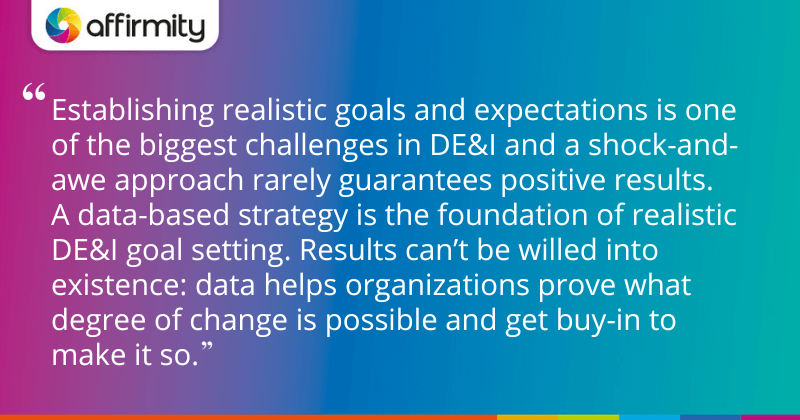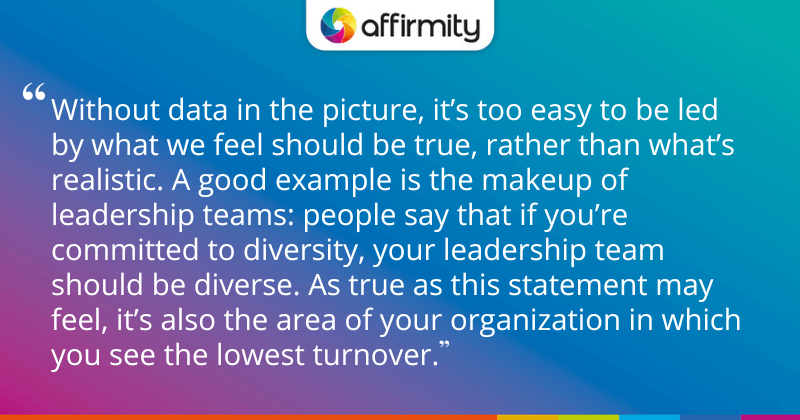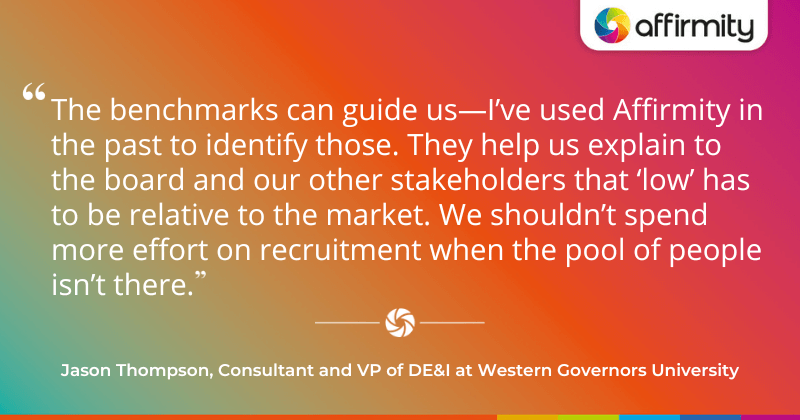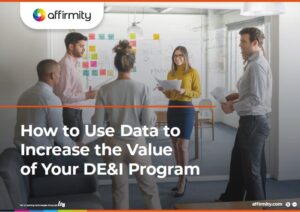While DE&I strategies need to be driven by data if they’re to be successful, simply having data available won’t solve all of your problems. You’ll need the right data points and you’ll need to use them in a way that properly informs your program. In this article, and with input from Affimity experts and contributors, we take a closer look at the problems created by unrealistic goal setting and how to use data to keep your plans grounded.
Why Is It Important to Set Realistic DE&I Goals and Targets?

It can be tempting for organizations to announce aggressive, headline-grabbing DE&I goals in an attempt to make a mark and perhaps galvanize the business into decisive action. But establishing realistic goals and expectations is one of the biggest challenges in DE&I and a shock-and-awe approach rarely guarantees positive results.
Worse still, promises that aren’t backed by data can turn out to be impossible from the beginning. A classic example would be a new CEO setting a 50/50 goal for gender representation on the board in three years, only to realize that all of the board members have five-year terms.
A data-based strategy is the foundation of realistic DE&I goal setting. Results can’t be willed into existence: data helps organizations prove what degree of change is possible and get buy-in to make it so.
Realistic DE&I goals are important because:
- You, as a DE&I practitioner, want to be successful within the business by delivering on the promises you make
- Communicating well-rationalized goals and achieving them will build not only your credibility within your organization, but the credibility of your department and DE&I practice in general
- They demonstrate that you’re committed to your KPIs and your organization’s strategic goals
DELVE INTO INSIGHTS ON THE DE&I LANDSCAPE | ‘5 Important Questions Answered in the 2023 Future of Diversity, Equity, Inclusion, and Belonging Report’

What to Do When Realistic Goals Become Unrealistic
There will of course be times when even realistic goals become unrealistic through no fault of your own. Prior to working with Affirmity, DE&I Consultant and Product Manager Joe Valenzuela worked at a range of different organizations in the insurance, legal, tech, and financial services industries, and he has seen carefully laid plans hit unforeseen roadblocks.
“A prime example was during COVID,” Valenzuela explains. “I was in the middle of building a DE&I program, and then COVID hit and all my goals went out the door. Attrition was extremely high. We started hiring, so it skewed the numbers.” He’s pragmatic about responding to the unexpected, however: “So what does that mean? We have to adjust as professionals and pivot. If you communicate to leaders what you’re doing, why the timeline has to change, and the specifics of how you’re going to pivot, you’ll retain your hard-won credibility.”
Valenzuela also describes a time when a strategic shift within the business—targeting increased market share in the Spanish-speaking market—required an adjustment of DE&I strategy. “So we’re in a strategy meeting and quickly realized that the company did not have enough talent within the organization that spoke Spanish. We took two actions: we decided to build a large call center, in order for us to house individuals to service our new clientele. And in staffing this call center we were able to bring our diversity recruiting into play.”
“And so I immediately started mapping to Hispanic Serving Institutions (HSIs) and attracting, recruiting, and hiring talent to fill the call center. It was very successful. We increased market share tremendously within that market.”

How Can Organizations Use Data to Establish Realistic Goals?
Without data in the picture, it’s too easy to be led by what we feel should be true, rather than what’s realistic. A good example is the makeup of leadership teams: people say that if you’re committed to diversity, your leadership team should be diverse. As true as this statement may feel, it’s also the area of your organization in which you see the lowest turnover. Nobody wants to increase turnover, and while you can make sure you have succession measures in place to eventually address this, for many organizations this goal becomes realistic only in the long term.
Data helps you set realistic goals and it also helps you understand the full context of your current performance. An engineering business may look at its workforce and realize that only 10% are women. While this feels very low, if women make up only 7% of the engineers in the firm’s sector, that 10% is cast in a different light.
This isn’t to say that 10% representation doesn’t still feel low. But it does provide a basis for realigning resources. Jason Thompson, VP of DE&I at Western Governors University, consultant, and a long-time Affirmity user and collaborator explains: “With this information, you could realign your resources and start working more in the thought leadership space. We’d like to do better, but we need to encourage more people to come into the industry, more people to get those degrees.”
He continues: “The benchmarks can guide us—I’ve used Affirmity in the past to identify those. They help us explain to the board and our other stakeholders that ‘low’ has to be relative to the market. We shouldn’t spend more effort on recruitment when the pool of people isn’t there. We should spend more effort on other tactics and other areas of concern.”
MORE ON SMARTER DATA USE | ‘3 Ways to Use Affirmative Action Data to Build Better Business Engagement and Accountability’
What Kind of Data Should Organizations Use?
Goals should be informed by a range of data points from a variety of internal and external sources. This may include:
- Your own utilization of available labor
- Industry benchmarks for utilization
- Benchmarking of utilization among your peers
- Hiring and talent decision statistics
- Compensation data
- Employee engagement metrics
- Employee participation in Employee Resource Groups (ERGs) and events
- Engagement with internal and external communications, such as newsletters and social media
- Environmental, Social, and Governance (ESG) metrics
Data, when properly handled and validated, can be pulled in from a wide range of sources and this list isn’t exhaustive. Newer sources, such as ERG programs, are opening up data points that have been traditionally harder to collect. Roy Zambonino, Senior Solutions Consultant at Affirmity explains: “We’re seeing now that with the advent of ERG platforms that information on age, demographics, and LGBTQ+ status is being more freely volunteered. It’s becoming more feasible to include that information with your traditional data points, such as race, gender, veteran status, and disability.”
FURTHER DE&I INSIGHTS FROM THE BLOG | ‘Why Meritocracy Remains a Myth for Women in the Workplace—And What You Can Do to Smash the Glass Ceiling’
Learn How to Use Data to Improve Your DE&I Program: Download Our Guide
These insights on realistic DE&I goal setting come from our guide, “How to Use Data to Increase the Value of Your DE&I Program”. Featuring even more practical real-world examples and data-driven techniques from Roy Zambonino, Joe Valenzuela, and Jason Thompson, the full guide additionally covers:
- Why you should develop a data-driven DE&I strategy
- How organizations can hold leaders accountable for DE&I objectives
- What tools and practices are needed to manage DE&I efforts
- And more!

Download the full guide today.
About the Author

Jeffery D. Lewis is co-managing director for Affirmity. He oversees professional services and sales for Affirmity’s affirmative action consulting services and diversity planning programs. He leads teams of consultants who deliver services spanning affirmative action, EEO compliance, and diversity planning. He also oversees a team of experts who specialize in evaluating allegations of discriminatory employment practices.
With more than 35 years with the company, Mr. Lewis has assisted hundreds of clients across numerous industries. He regularly presents executive seminars on all aspects of affirmative action and diversity management.
